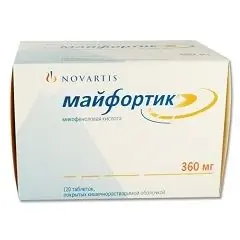- Author Rachel Wainwright [email protected].
- Public 2023-12-15 07:39.
- Last modified 2025-11-02 20:14.
Mayfortic
Mayfortik: instructions for use and reviews
- 1. Release form and composition
- 2. Pharmacological properties
- 3. Indications for use
- 4. Contraindications
- 5. Method of application and dosage
- 6. Side effects
- 7. Overdose
- 8. Special instructions
- 9. Application during pregnancy and lactation
- 10. Use in childhood
- 11. In case of impaired renal function
- 12. For violations of liver function
- 13. Use in the elderly
- 14. Drug interactions
- 15. Analogs
- 16. Terms and conditions of storage
- 17. Terms of dispensing from pharmacies
- 18. Reviews
- 19. Price in pharmacies
Latin name: Myfortic
ATX code: L04AA06
Active ingredient: mycophenolic acid (Mycophenolic acid)
Producer: Novartis Pharma Stein, AG (Novartis Pharma Stein, AG) (Switzerland)
Description and photo update: 2019-07-02

Mayfortic is an immunosuppressive agent.
Release form and composition
The drug is produced in the form of enteric-coated tablets: dosage 180 mg - round, with beveled edges, pale green, on one side marked "C"; dosage 360 mg - oval, gray-pink color, on one side marked "ST" (10 pieces in a blister, in a cardboard box of 5, 6, 10, 12 or 25 blisters and instructions for use of Mayfortic).
1 tablet contains:
- active substance: sodium mycophenolate - 192.4 or 384.8 mg (equivalent to mycophenolic acid in the amount of 180 and 360 mg, respectively);
- additional components: crospovidone, corn starch, anhydrous lactose, povidone (K-30), magnesium stearate, colloidal silicon dioxide;
- enteric coating: titanium dioxide (No. 77891, E 171), hypromellose phthalate, iron oxide yellow (No. 77492, E 172); additionally for a dosage of 180 mg - indigo carmine (E 132), for a dosage of 360 mg - iron oxide red (No. 77491, E 172).
Pharmacological properties
Pharmacodynamics
Mayfortic is an immunosuppressive drug that suppresses the production of guanosine nucleotides by selectively inhibiting inosine monophosphate dehydrogenase, a key enzyme in purine synthesis. Thanks to this mechanism, the active substance of the agent effectively prevents the proliferation of T- and B-lymphocytes, while suppressing this process to a much greater extent than other cells, since the proliferation of lymphocytes is mainly influenced by de novo purine synthesis.
The suppression of the proliferation of T- and B-lymphocytes by the drug complements the effect of calcineurin inhibitors, which disrupt the production of cytokines and act on T-lymphocytes in the resting stage of the cell cycle.
Pharmacokinetics
After oral administration, sodium mycophenolate is intensively absorbed. Due to the available enteric film coating, the maximum concentration (C max) of mycophenolic acid (IFC) is observed 1.5-2 hours after administration. During in vitro studies, it was found that the special composition of the film coating does not allow the release of IFC in an environment similar to the acidic environment of the stomach.
With a stably functioning renal transplant in patients receiving cyclosporine in the form of a microemulsion as a basic immunosuppressive therapy, the degree of IFC absorption from the gastrointestinal tract (GIT) is 93%, and the bioavailability is 72%. The pharmacokinetics of IFC has a linear dose-dependent character in the dose range from 180 to 2160 mg. The area under the pharmacokinetic curve (AUC) when using the drug on an empty stomach does not differ from that when taking Mayfortic with food rich in fat (55 g fat, 1000 calories). At the same time, C max of IFC in this case decreases by 33%.
The apparent volume of distribution (V SS) of the IFC at equilibrium is 50 liters. For IFC and its phenolic glucuronide (HMPA), a high degree of binding to blood proteins is characteristic - 97 and 82%, respectively. Against the background of a decrease in the number of sites of communication with proteins in liver failure, uremia, hypoalbuminemia, as well as combination therapy with drugs with high binding to plasma proteins, an increase in the level of free IFC in plasma may be observed.
Metabolic transformation of IFC is carried out mainly with the participation of glucuronyl transferase, as a result of which the main pharmacologically inactive metabolite of HMPA is formed. With stable functioning of the renal graft in patients receiving basic immunosuppressive treatment with cyclosporine in the form of a microemulsion, approximately 28% of an oral dose of Mayfortic is metabolized to HMPA as a result of the first passage through the liver.
The half-life (T ½) of IFC and HMPA is 11.7 and 15.7 hours, respectively, clearance is 8.6 and 0.45 l / h. Most of the IFC is excreted in the urine in the form of HMPA and, to a much lesser extent, unchanged (less than 1%). HMPA is also excreted in the intestine with bile, where it is broken down by the intestinal flora by deconjugation. The IFC formed during this cleavage process can then be reabsorbed. 6-8 hours after taking Mayfortic, the second maximum level of IFC content is observed, which corresponds to the re-absorption of deconjugated IFC.
Below are the average values of the main pharmacokinetic parameters of IFC after oral administration of Mayfortic, established in patients who have undergone kidney transplantation and receive basic immunosuppressive treatment with cyclosporine in the form of a microemulsion. The recommended oral dose is 720 mg.
In adult patients [indicated: T max * (h) / C max (μg / ml) / AUC (μg × h / ml)]:
- single dose (n = 24): 2 / 26.1 (12) / AUC 0-∞ 66.5 (22.6);
- repeated doses 6 days 2 times / day (n = 12): 2.5 / 37 (13.3) / AUC 0-12 67.9 (20.3);
- repeated doses 28 days 2 times / day (n = 36): 2.5 / 31.2 (18.1) / AUC 0-12 71.2 (26.3);
- long-term treatment 2 times / day (n = 48), 14 days after transplantation: 2 / 13.9 (8.6) / AUC 0-12 29.1 (10.4);
- long-term treatment 2 times / day (n = 48), 3 months after transplantation: 2 / 24.6 (13.2) / AUC 0-12 50.7 (17.3);
- long-term treatment 2 times / day (n = 48), 6 months after transplantation: 2/23 (10.1) / AUC 0-12 55.7 (14.6).
* Time to reach maximum plasma concentration.
There were no significant differences in pharmacokinetic parameters depending on the sex of the patients.
Renal function does not affect the pharmacokinetics of IFC; in case of impaired renal activity, an increase in HMPA AUC is noted, for example, in the presence of anuria, HMPA AUC values increase by about 8 times. Hemodialysis does not affect the clearance of IFC and HMPA. In patients with renal insufficiency, the level of free IFC in plasma may increase significantly, which is presumably due to a decrease in the binding of IFC to proteins at a high concentration of urea in the blood.
In alcoholic cirrhosis of the liver, the effect of this lesion on the course of IFC glucuronidation reactions was not recorded. The absence or presence of the effect of liver disease on the pharmacokinetics of IFC may be due to the nature of the disease (predominant lesion of the biliary system or parenchyma, or other).
Indications for use
Mayfortic is recommended for the prevention of acute graft rejection in patients with allogeneic kidney transplants receiving basic immunosuppressive therapy with cyclosporine (in the form of a microemulsion) and glucocorticosteroids.
Contraindications
Absolute:
- childhood;
- breast-feeding;
- lactose intolerance, lactase deficiency, glucose-galactose malabsorption;
- hypersensitivity to any of the constituents of Mayfortic, MKF and mycophenolate mofetil.
Relative (drug therapy should be carried out with caution):
- diseases of the gastrointestinal tract during an exacerbation;
- congenital deficiency of hypoxanthine-guanine phosphoribosyltransferase (including in patients with Kelly-Sigmiller and Lesch-Nyhen syndromes).
For pregnant women, Mayfortic can only be prescribed if the intended effect of the treatment for the mother far exceeds the possible threat to the fetus.
Mayfortik, instructions for use: method and dosage
Mayfortic is taken orally, on an empty stomach or with food. The tablets must be swallowed whole without chewing or breaking.
Patients who have not previously received the drug are recommended to start taking it within the first 48 hours after transplantation, 2 times a day, 720 mg each (4 tablets of Mayfortic 180 mg or 2 tablets of Mayfortic 360 mg). The daily dose is 1440 mg. In the case of previous treatment with mycophenolate mofetil at a dose of 2000 mg, it can be replaced by Mayfortic at a dose of 720 mg 2 times a day.
Changes in the pharmacokinetics of IFC are not recorded in the case of a graft rejection reaction. In this case, it is not required to adjust the dosage regimen.
Side effects
Below are the undesirable effects recorded while taking Mayfortic in a daily dose of 1440 mg for 1 year in combination with cyclosporine microemulsion and corticosteroids in two clinical studies in patients with a de novo renal transplant and in patients with a kidney transplant who had previously received maintenance treatment. These adverse reactions had a probable or possible causal relationship with the use of Mayfortic.
The incidence of adverse reactions is estimated as follows: very often - ≥ 10%; often - ≥ 1% and <10%; sometimes - ≥ 0.1% and <1%:
- circulatory and lymphatic systems: very often - thrombocytopenia, anemia; sometimes - neutropenia, lymphopenia *, lymphocele *, lymphadenopathy *;
- infections and infestations: very often - bacterial, fungal and viral infections; often - upper respiratory tract infections; sometimes - wound infections, osteomyelitis *, sepsis;
- respiratory system, chest and mediastinal organs: often - cough; sometimes - stridor, congestive lung *;
- nervous system: often - headache; sometimes - insomnia *, tremor;
- mental disorders: sometimes - delusional perception *, sleep disturbances *;
- digestive system: very often - diarrhea; often - flatulence, bloating, nausea, loose stools, vomiting, abdominal pain, dyspepsia, constipation, gastritis; sometimes - dry mouth, belching, gingival hyperplasia, discoloration of the tongue, bad breath, ulceration of the lips, tension of the abdominal wall, blockage of the parotid excretory duct *, gastrointestinal bleeding, gastroesophageal reflux disease, intestinal obstruction, subileus *, peptic ulcer *, esophagitis *, peritonitis, pancreatitis;
- liver: often - abnormal liver function tests;
- skin and subcutaneous tissue: sometimes - bruises *, alopecia;
- cardiovascular system: sometimes - tachycardia, ventricular extrasystoles *, pulmonary edema *;
- endocrine system and metabolism: sometimes - hyperlipidemia, anorexia, hypophosphatemia *, hypercholesterolemia, diabetes mellitus *;
- general disorders: often - pyrexia, fatigue; sometimes - weakness *, thirst *, pain, tremor *, swelling of the lower extremities *, flu-like diseases;
- organ of vision: sometimes - blurred vision *, conjunctivitis *;
- reproductive system: sometimes - impotence;
- urinary system: often - an increase in the content of creatinine in the blood; sometimes - urethral stricture, renal tubular necrosis, hematuria *;
- musculoskeletal system and connective tissue: sometimes - muscle cramps *, back pain *, arthritis *;
- benign and malignant tumors: sometimes - lymphoproliferative disorders, skin papilloma *, squamous cell carcinoma *, Kaposi's sarcoma *, basal cell carcinoma *.
* This adverse reaction was recorded in only 1 patient out of 372.
Below are the violations that were observed against the background of taking funds that include the IFC (class effects):
- hematopoietic system: pancytopenia, neutropenia; with the combination of mycophenolate mofetil with other immunosuppressants - isolated cases of the appearance of partial red cell aplasia of the bone marrow (PKKA);
- infections and invasions: infectious lesions of a severe course, sometimes life-threatening (in some cases with a fatal outcome), including tuberculosis, infective endocarditis, meningitis, atypical infections caused by mycobacteria; polyomavirus nephropathy (especially associated with the BK virus); when using mycophenolate mofetil, which is an IFC derivative, - progressive multifocal leukoencephalopathy (PML), in some cases with a fatal outcome;
- digestive system: esophagitis, colitis [including cytomegalovirus esophagitis (CMV esophagitis), CMV colitis], pancreatitis, CMV gastritis, perforation of the intestinal wall, gastric ulcer and / or duodenal ulcer, gastrointestinal hemorrhage …
Overdose
Overdose cases of Mayfortic were not recorded. Despite the elimination of the inactive HMPA metabolite by hemodialysis, it is not assumed that this method can effectively excrete active IFC from the body in clinically significant amounts. This is due to the binding of IFC to plasma proteins by almost 97%. Bile acid sequestrants, including cholestyramine, interfere with the absorption of IFC from the intestine and, as a result, can lead to a decrease in its level in the blood.
special instructions
Only qualified transplant doctors should prescribe and carry out treatment with Mayfortic.
In patients receiving combined immunosuppressive therapy, including Mayfortic, the risk of lymphomas and other malignant lesions, especially the skin, increases.
Cases of genotoxic effects of Mayfortic have been recorded. This threat is most likely associated not with its intake, but with the duration of the course and the intensity of immunosuppressive therapy. In order to reduce the likelihood of developing malignant neoplasms of the skin, it is recommended to use sunscreen with a high protection factor to reduce exposure to ultraviolet radiation and sunlight, and protect the skin with closed clothing.
It is necessary to urgently consult a doctor if, during therapy, an infection develops, the unexpected appearance of hematomas, bleeding and any other manifestations of bone marrow suppression.
Excessive immunosuppression increases the risk of infections, including opportunistic infections, as well as sepsis and fatal infections.
In persons receiving therapy with IFC derivatives (mycophenolate mofetil, Mayfortik), reactivation of the infection caused by hepatitis B and C viruses was noted. As a result, in infected patients, it is required to monitor clinical symptoms and laboratory indicators of the activity of the infectious process.
With the use of mycophenolate mofetil, cases of PML have been reported, mainly in the presence of risk factors for the development of this complication, including treatment with immunosuppressive drugs and immune disorders. It is required to take into account the possibility of the appearance of PML during the period of taking Mayfortic in patients with reduced immunity; patients with neurological disorders, if necessary, should be referred for a consultation with a neurologist.
The occurrence of polyomavirus nephropathy, especially associated with the BK virus, should be taken into account in the differential diagnosis of the causes of functional liver disorders detected during immunosuppressive therapy. If polyomavirus nephropathy or PML develops, consideration should be given to reducing the immunosuppressive load. However, with a decrease in the intensity of immunosuppression in patients after transplantation, the risk of transplant rejection increases.
During the period of treatment with Mayfortic, the occurrence of neutropenia caused by the effect of IFC, concomitant medication, viral infections or a combination of these factors is not excluded. When using Mayfortic, it is recommended to regularly determine the number of leukocytes and the blood formula: weekly - during the first month of the course, 2 times a month - during the second and third months, once a month - starting from the fourth month and until the end of the first year of therapy. In case of development of neutropenia, if the absolute number of neutrophils is less than 1.5 × 10 3 / mm 3, it is advisable to stop or interrupt the drug intake.
There are reports of the development of PACA against the background of the use of mycophenolate mofetil or mycophenolate sodium in combination with other immunosuppressants. Currently, the mechanism of PACA development during therapy with IFC derivatives is unknown, and the effect of other immunosuppressants and their combinations has not been established either. In some cases, it was possible to normalize the patient's condition after a dose reduction or discontinuation of mycophenolate mofetil therapy. The dosage regimen of Mayfortic should be adjusted only with careful monitoring of the patient's condition in order to reduce the risk of graft rejection.
It should be remembered that the effect of vaccination may be weakened during therapy with IFC derivatives and that the use of live attenuated vaccines should be avoided. Influenza vaccination should be carried out in accordance with local health authorities' recommendations for influenza virus vaccination.
The efficacy and safety of using Mayfortic with immunosuppressive drugs has not been studied. It was used in combination therapy with the following drugs: cyclosporine (in the form of a microemulsion), glucocorticoids, basiliximab, antithymocyte globulin.
Influence on the ability to drive vehicles and complex mechanisms
During the period of drug therapy, the possibility of the development of adverse events should be taken into account and caution should be exercised when performing work that requires concentration.
Application during pregnancy and lactation
When using Mayfortic during pregnancy, an aggravation of the threat of the development of congenital anomalies was recorded. According to the US National Transplant Pregnancy Registry (NTPR), babies whose mothers have had organ transplants has an average incidence of birth defects of 4-5%.
Controlled clinical trials of Mayfortic therapy in pregnant women have not been conducted, but according to the NTPR, when using mycophenolate mofetil in combination with other immunosuppressants during pregnancy, an increase in the incidence of congenital malformations was noted - by 22% (4 children out of 18 newborns), compared with the average frequency. These most common pathologies included anomalies in the development of the inner ear, craniofacial region (including clefts of the upper lip and palate), extremities, congenital diaphragmatic hernias and heart defects. Also, the use of mycophenolate mofetil during pregnancy significantly exacerbated the risk of spontaneous abortion. When taken orally or in / in the introduction of mycophenolate, mycophenolate turns into IFC, which has been shown to have a teratogenic effect in preclinical studies in animals.
Mayfortic during pregnancy can only be used when the intended effect of the treatment far exceeds the possible threat to the fetus.
It is not recommended to start taking Mayfortic until a negative pregnancy test result is obtained. If pregnancy has been diagnosed, it is necessary to urgently consult a doctor.
Before starting the course of treatment with the drug, during its entire course and for 6 weeks after its completion, reliable methods of contraception should be used.
Whether IFC is excreted in human milk is unknown. If it is necessary to take Mayfortic during lactation, the issue of stopping breastfeeding during the entire period of treatment and for 6 weeks after its completion should be resolved.
Pediatric use
Treatment with the drug is contraindicated in children, since the effectiveness and safety of its administration in patients of this age category have not been studied. In patients under 18 years of age who have undergone kidney transplantation, there are limited data on the pharmacokinetics of the drug. Currently, there are no specific recommendations for the dosage regimen of Mayfortic in children.
With impaired renal function
Patients with delayed recovery of renal graft function do not need to adjust the dose of Mayfortic.
Patients with severe chronic renal impairment (with a glomerular filtration rate below 25 ml / min / 1.73 m 2) require careful monitoring.
For violations of liver function
In severe liver disease caused by a predominant lesion of the parenchyma, it is not required to change the dose of Mayfortic.
Use in the elderly
According to preliminary research data, it was found that the concentration of IFC does not change clinically with age, and therefore no dosage adjustment is required in elderly patients. It should be borne in mind that in elderly patients the threat of side effects is exacerbated by the phenomena of immunosuppression.
Drug interactions
- acyclovir: there may be an increase in the level of both acyclovir and HMPA, probably due to a similar way of excretion of these drugs - tubular secretion; this combination requires careful observation;
- azathioprine: there have been no specific studies of the interaction of azathioprine and Mayfortic, so they should not be used simultaneously;
- live vaccines: it is not recommended to administer them to patients with an impaired immune response; antibody production with other vaccines may be reduced;
- antacids containing aluminum and magnesium hydroxide: the absorption of sodium mycophenolate decreases, as a result of which the AUC and C max of IFC are reduced by 37 and 25%, respectively; this combination requires caution;
- cyclosporine: in patients with stable renal transplant, no changes in the pharmacokinetics of cyclosporine are observed against the background of equilibrium concentrations of Mayfortic;
- ganciclovir: no effect of ganciclovir on the pharmacokinetics of IFC and HMPA was noted; the clearance of ganciclovir does not change when the therapeutic concentration of IFC is reached; when carrying out combined treatment with Mayfortic and ganciclovir in the presence of impaired renal activity, it may be necessary to correct the dosage regimen of the latter; such patients require close supervision;
- cholestyramine and drugs that affect enterohepatic circulation: a decrease in AUC and the level of IFC in the blood is possible, due to the ability of these drugs to bind bile acids in the intestine; with this combination therapy, caution is required due to the risk of reducing the effectiveness of Mayfortic;
- proton pump inhibitors (pantoprazole): with the combined use of mycophenolate mofetil 1000 mg and pantoprazole 40 mg 2 times a day, there is a decrease in C max and AUC of IFC by 57 and 27%, respectively; however, with the combination of Mayfortic with pantoprazole, changes in the pharmacokinetic parameters of IFC were not recorded;
- tacrolimus: with the combined use of tacrolimus with Mayfortic in patients with a stable kidney transplant, there is an increase in the mean AUC of IFC by 19% and a decrease in C max of IFC by 20% in comparison with those when the latter is combined with Sandimmun Neoral; with the combination of Mayfortic with tacrolimus, the decrease in AUC and C max values for HMPA was 30% in comparison with the combined administration of Mayfortic with Sandimmun Neoral;
- oral contraceptives: these drugs are metabolized by oxidation reactions, and Myfortic - by glucuronidation, therefore, the effect of these drugs on the pharmacokinetics of Myfortic is unlikely, however, since the effect of the latter on the pharmacokinetic parameters of oral contraceptives has not been studied, the possible risk of reducing the therapeutic effect of contraceptives cannot be excluded.
Analogs
The analogues of Mayfortic are: Felomika, Mycophenolic acid-TL, Mycophenolic acid, etc.
Terms and conditions of storage
Store out of the reach of children at a temperature not exceeding 30 ° C.
The shelf life is 2.5 years.
Terms of dispensing from pharmacies
Dispensed by prescription.
Reviews about Mayfortica
There are very few reviews of Mayfortica on medical sites and they are quite contradictory. Some patients consider the drug to be an extremely important immunosuppressive agent used for the prevention of transplant rejection in patients with allogeneic kidney transplants. Others point out that the drug, even with prolonged use, does not always demonstrate the expected therapeutic effect, but at the same time often leads to the development of undesirable reactions. Also, many consider its high cost to be a disadvantage of the drug.
The price of Mayfortic in pharmacies
The price for Mayfortic 180 mg can be 2600-5100 rubles. for 100 tablets. The cost of Mayfortic 360 mg is 5500-6150 rubles. for 120 tablets.

Anna Kozlova Medical journalist About the author
Education: Rostov State Medical University, specialty "General Medicine".
Information about the drug is generalized, provided for informational purposes only and does not replace the official instructions. Self-medication is hazardous to health!






